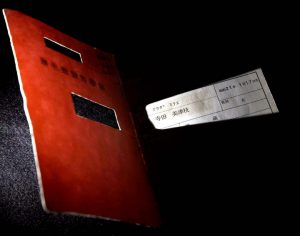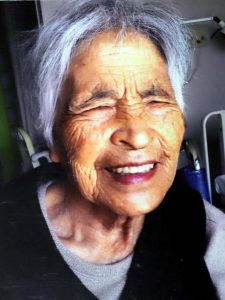Documenting Hiroshima 80 years after A-bombing: In February, raising child in darkness after losing eyesight in bombing
Feb. 8, 2025
by Minami Yamashita, Staff Writer
In February 1946, Tomeko Fukuchi, 26 at the time, an atomic bomb survivor who had lost sight in both eyes in the atomic bombing, was struggling to raise her newborn second daughter, Mitsue. To breastfeed the baby, she would guide Mitsue’s small lips to nurse with her hands, but would fail at times, occasionally causing both the mother and the baby to cry. She had no other option but to touch her hands to her child’s face, which she was unable to see.
Ms. Fukuchi had experienced the atomic bombing near Hiroshima Station when she was five-months pregnant. Both her eyes were hit by glass shards thought to have been carried on the bomb’s blast. She lost her sight immediately, but by asking a man she did not know for help and other means, she was able to flee to Yaga National School (present-day Yaga Elementary School in Hiroshima’s Higashi Ward) and reunite with her family.
In the midst of the chaos at that time, she did not receive adequate medical treatment, and it was only three months later that she was finally admitted to a hospital in Kurashiki City. However, she left the hospital at the end of the year without being fully healed, given the accumulating medical expenses and the upcoming birth of her baby. On a cargo train she and her mother were taking to return to Hiroshima, her mother asked, “Why don’t we die together?” Tomeko cried and refused her mother’s entreaty. She would not take the life of the baby in her womb.
On January 17, 1946, she gave birth to Mitsue at home in the area of Kusatsu-honmachi (in Hiroshima’s present-day Nishi Ward). The hard part was just beginning. Feeling her way around, she did her best to nurse Mitsue, change her diapers, and bathe her. She once singed her own hair while cooking rice at the kitchen hearth. Sharing the housework with her husband and other family members, she also received help from her relatives and neighbors. She gave birth to a third daughter in 1948, and a second son in 1950. To earn a living, she entered a school for the visually impaired at the age of 32, got work as a masseuse, and raised their five children.
In a video produced by the Hiroshima Peace Memorial Museum in 2006 designed to record testimonies of A-bombing experiences, Tomeko said, “I even hate to say the word ‘A-bomb.’ I want to see again. Brightness.” Mitsue, 79, a resident of Hiroshima’s Asaminami Ward whose family name is now Terada by marriage, bit her lip and said, “I wanted to show myself in wedding attire to my mother. I can’t forget how she twice patted my tsunokakushi (cloth bridal headdress) and said, ‘You’re beautiful’ at the time of my wedding ceremony.”
Tomeko died in 2013 at the age of 94. After her body was cremated, staff told Mitsue the glass shards that had blinded her mother had dissolved and were no longer there. Mitsue said, “If glass had been found in her remains, I was thinking about voicing my complaints to it, but I was convinced my mother had returned to a world of brightness from the darkness. A weight was lifted from my chest.”
(Originally published on February 8, 2025)
In February 1946, Tomeko Fukuchi, 26 at the time, an atomic bomb survivor who had lost sight in both eyes in the atomic bombing, was struggling to raise her newborn second daughter, Mitsue. To breastfeed the baby, she would guide Mitsue’s small lips to nurse with her hands, but would fail at times, occasionally causing both the mother and the baby to cry. She had no other option but to touch her hands to her child’s face, which she was unable to see.
Ms. Fukuchi had experienced the atomic bombing near Hiroshima Station when she was five-months pregnant. Both her eyes were hit by glass shards thought to have been carried on the bomb’s blast. She lost her sight immediately, but by asking a man she did not know for help and other means, she was able to flee to Yaga National School (present-day Yaga Elementary School in Hiroshima’s Higashi Ward) and reunite with her family.
In the midst of the chaos at that time, she did not receive adequate medical treatment, and it was only three months later that she was finally admitted to a hospital in Kurashiki City. However, she left the hospital at the end of the year without being fully healed, given the accumulating medical expenses and the upcoming birth of her baby. On a cargo train she and her mother were taking to return to Hiroshima, her mother asked, “Why don’t we die together?” Tomeko cried and refused her mother’s entreaty. She would not take the life of the baby in her womb.
On January 17, 1946, she gave birth to Mitsue at home in the area of Kusatsu-honmachi (in Hiroshima’s present-day Nishi Ward). The hard part was just beginning. Feeling her way around, she did her best to nurse Mitsue, change her diapers, and bathe her. She once singed her own hair while cooking rice at the kitchen hearth. Sharing the housework with her husband and other family members, she also received help from her relatives and neighbors. She gave birth to a third daughter in 1948, and a second son in 1950. To earn a living, she entered a school for the visually impaired at the age of 32, got work as a masseuse, and raised their five children.
In a video produced by the Hiroshima Peace Memorial Museum in 2006 designed to record testimonies of A-bombing experiences, Tomeko said, “I even hate to say the word ‘A-bomb.’ I want to see again. Brightness.” Mitsue, 79, a resident of Hiroshima’s Asaminami Ward whose family name is now Terada by marriage, bit her lip and said, “I wanted to show myself in wedding attire to my mother. I can’t forget how she twice patted my tsunokakushi (cloth bridal headdress) and said, ‘You’re beautiful’ at the time of my wedding ceremony.”
Tomeko died in 2013 at the age of 94. After her body was cremated, staff told Mitsue the glass shards that had blinded her mother had dissolved and were no longer there. Mitsue said, “If glass had been found in her remains, I was thinking about voicing my complaints to it, but I was convinced my mother had returned to a world of brightness from the darkness. A weight was lifted from my chest.”
(Originally published on February 8, 2025)









